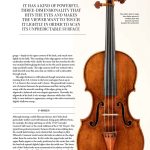Giovanni Antonio Marchi was born on 24 April 1727 in a small village on the outskirts of Bologna. His family had a long tradition of woodworking, but he lost his father when he was eight and was then raised by his uncle Natale. In around 1745 he moved with his family to the city itself. Marchi started working as a violinaro (violin maker) around 1755, when he would have been 28. This information comes directly from his own words, taken from the preface of the book on violin making that he wrote in 1786 but which was never published during his lifetime. The book, preserved in Bologna’s Archiginnasio public library, was examined and published in 1986 by the Bolognese violin maker Roberto Regazzi, who undertook intensive research both on Marchi himself and on the milieu of the city in that period. Not much is known about Marchi’s apprenticeship, but it seems very likely that he was trained by the well-known violin maker Giovanni Fiorino Guidante (called ‘Joannes Florenus Guidantus’on his labels), who was active in Bologna in the first half of the 18th century. By the time Marchi started working on his book, he had gained a reputation as an accomplished restorer and his fame reached Count Cozio di Salabue who, in the early 19th century, contacted him in order to purchase instruments (he was searching for violins by Dom Nicolaus Amati in particular). Cozio admired Marchi’s work and he tried to convince him to work for him in Milan as conservator and restorer of his collection, but owing to his extended years, Marchi turned down the position and he died shortly afterwards, on 20 December 1807. There is little information to be found about Marchi’s pupils. In a letter from 1805 he mentions a ‘pupil from Rome who was sent to me by Prince Giustiniani’. He had a great influence on the Bolognese violin makers of his age in general, and it is possible that he also trained Giovanni Varotti and the Tadolini Brothers.’
Marchi’s Manuscript on Violin Making is still the only extant written work by an 18th-century Italian violin maker, and it reflects its author’s personality. Written in good Italian, it demonstrates
that Marchi was a well-educated man. The book was not conceived as a manual for luthiers based solely on measurements and technical methods. Instead, it goes into detail on the basic acoustic and architectural principles of violin making, and it reveals Marchi’s philosophy of making: divided into 13 chapters, it covers matters such as the motto tremulo (‘vibrating motion’, or resonance), as well as the principles of soundpost setting, the quality of wood, the varnish and much more. In addition, the book is surprisingly enjoyable to read on account of the writer’s frequently ironic comments on the superficiality of the violin making business, the mythology, and the ‘fake news’ that (even today) are part of the violin trade.
Quotes taken from the luthier’s Manuscript on Violin Making:
- I have found so many beliefs [about violin making] that if people believed as much in the supernatural, they would surely accumulate capital for the afterlife.
- People believe the good quality of instruments is only to be attributed to the varnish, because oil keeps the wood softer and gives the tone a human, rich character. Practice teaches us the reverse about this varnish: it is well known that the drier the oily parts of the wood [are], the better the sound.
- There is a violin maker these days who, having applied such an oil varnish to one of his instruments, has been compelled to wait for a year to pass before the air could dry the wood again so that the instrument would produce the same result when used before being varnished […] I think that is enough to prove that oil varnish is not possible to be an advantage for the instruments.
- It is important […] not to attribute to the
wood the mistake of the violin maker.
Form and Construction
Made in the mid-1770s, the violin shown here was made
on a model by Jacob Stainer, a luthier whose work was much admired by Marchi. According to Marchi’s notes, he carefully studied the work of the great German maker and this was probably his favourite model for new violins. This example certainly shows Marchi’s personality and it can be considered a perfect example of an instrument of the Bolognese school.
Archings and edgework
The archings are high: 19mm on the top plate, 17.5mm on the back. On the front, the profile is long and straight, quite flat in the central area and slightly bulky around the top- and bottom- blocks. The back is more round: looking from the side, the curve starts descending more gently over the central blocks. The workmanship is extremely accurate, and no toolmarks are visible. The edges are 3.3–3.5mm thick and the overhang changes considerably, from 2mm on the upper and lower bouts, up to 3.3mm at the C-bouts.
F-Holes
The Stainer model was followed well by Marchi and very carefully cut. The scoop in the lower wings is quite deep at the ends, and gently connected to the arching. It leaves a barely visible contour on the lower eye and on the lower side of the f-hole. The notches are sharp and delicately rounded on the edges, and the upper and lower wings are sharply pointed.
A perpendicular scribed line, now hardly noticeable, was used for tracing the f-holes.
Purfling
The purfling is thin, around 0.8–0.9mm. The ‘white’ is made from maple, and the ‘black’ of a well-stained hardwood with a glossy look. The strips are set at 3mm from the outside edge.
Scroll
In the carving of the scroll, Marchi did not intend to copy Stainer. Both the design and the workmanship appear to be
a product of his own character. The long pegbox is quite pointed at the throat, and in profile, the scroll always appears well rounded. In particular, the eye of the volute is quite peculiar, with a slight extension of the turn. The front view of the scroll is quite bold with a strong and rounded chamfer. All the workmanship is extremely clean, and shows a professional attitude in rounding and smoothing the cut.
Varnish
In his book, Marchi is quite sceptical about any ‘magic’ feature of the varnish. He seems to prefer alcohol-based varnish, because of the acoustic result as well as the ease of its application. The ground is brilliant and reflective and it shows a slight oxidation of the grain; the varnish itself is quite thin and a little hard, but pleasantly worked by wear and still a delicate, glowing yellow-orange colour.
Copyright © 2022 Alberto Giordano, The Strad magazine All rights reserved





